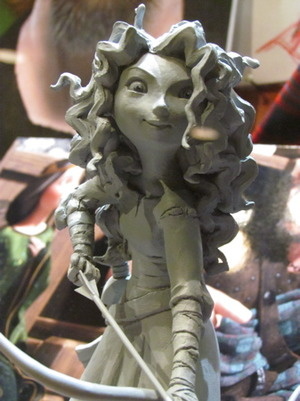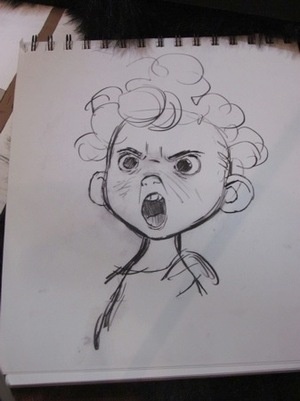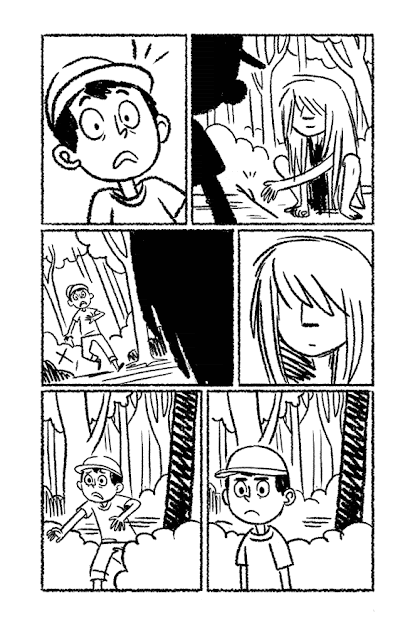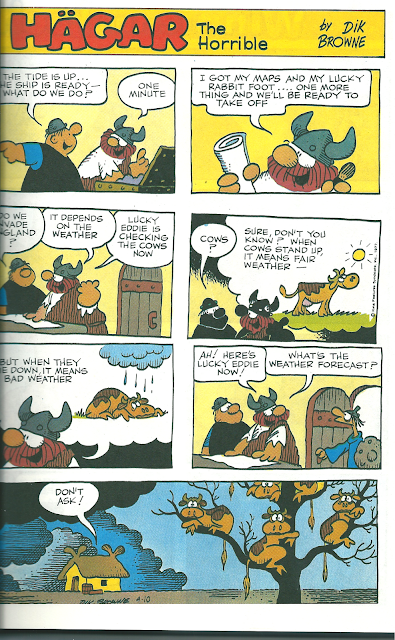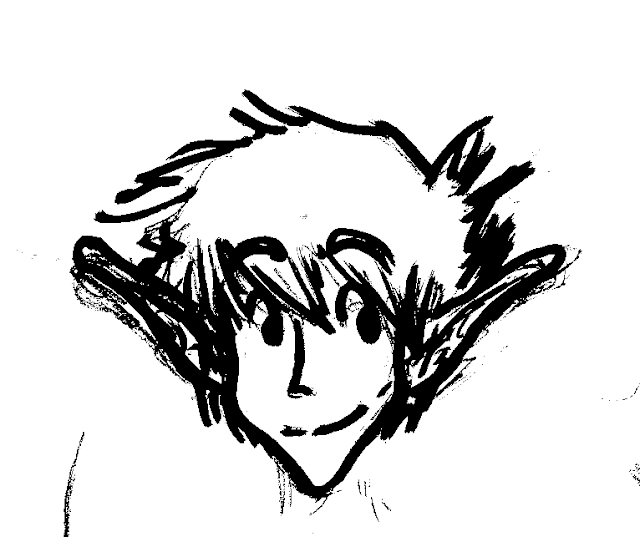Tuesday, 31 January 2012
Examples of the Form - Concept Art
Here are some examples of concept art from CGI animated films by such studios as Pixar and Dreamworks, which I studied for help and inspiration for my final piece. Such concept art ranges from models and sketches of character designs, to vast and detailed pieces of art of key scenes that will or may feature in the film.
Concept Art from "Brave"
Concept Art from "How to Train Your Dragon"
Concept Art from "The Incredibles"
Concept Art from "Brave"
Concept Art from "How to Train Your Dragon"
Concept Art from "The Incredibles"
Monday, 30 January 2012
Combinations of animals and humans - anthropomorphic animals (Sonic the Hedgehog)
The 'Sonic the Hedgehog' series has character designs that are good examples of animal features being combined with human ones. I decided to study my favourite group of characters, known collectively as the Chaotix, and draw them. These are the images (official art/character models) I referenced of the four characters, Vector the Crocodile, Mighty the Armadillo, Espio the Chameleon and Charmy Bee, who I drew; however, being familiar with the characters already, I found them relatively to draw:
Here are my drawings of them:
These drawings I them inked with a combination of India ink and fineliners:
Here are my drawings of them:
These drawings I them inked with a combination of India ink and fineliners:
Combinations of fictional animal qualities and human qualities; alliances between people and fictional animals (Pokemon!)
My anthropomorphic Pokemon character with a friend's (their original artwork for their character can be seen here).
Art for another online friend:
Sunday, 29 January 2012
Comparisons Between Female Slice-of-Life comic artists

My artist's copy of Melissa Mendes's characters from "Where-wolf?":
A couple of sketches of character ideas in the style of Melissa Mendes:
Hope Larson: an example of her work from "Salamander Dreams":
Vera Bee: An example of her work from "What were you raised by wolves?":
My artist's copies and emulations of her style:
Comparison between
works of Melissa Mendes, Hope Larson and Vera Bee
Melissa Mendes has a charming art
style which verges on childlike in its simplicity and abandonment of accuracy
in proportions or anatomy, and yet evidences a kind of control to her seemingly
erratic and random use of brushstrokes that only truly skilled artists can
achieve. Her character designs,
particularly her recurring character Freddy and the two protagonists of “Where-Wolf?”,
ooze character and individuality. In
comparison, Vera Bee has a much more consistent art style, although her
character designs are equally unique and appealing. While, like Mendes’ work, Bee’s art style is quite
minimalist, and also in-keeping with a child-like quality through the way her
lines are crayon-like in texture, there is something much more mature and organised
to Bee’s work. On the other hand, Mendes
applies a grey tone to her work, while Bee’s is purely black and white and
representing shadow with child-like black squiggles.
In contrast, Hope Larson has a
style that is more mature than both Mendes and Bee’s works, not just in her
actual style, but the way she uses brush and ink, giving her lines a dreamy, water-like
flow. Unlike the other two also, in her graphic
novel “Salamander Dream”, she applies colour to her work rather than just
monotone; just the one colour other than black and white is used, however:
green. This helps further the natural
and dream-like quality to the art and the story, along with the abstract use of
human biology incorporated into the story and artwork, for example when the two
main characters hop from one giant blood cell to the next and float among DNA
helixes, as well as the general use of random dotted or wiggly lines that
sometimes appear in the background. These
can all easily be construed as visual metaphors to be interpreted by the
reader, and gives the comic a deep, mature and meaningful impression.
While it can be said that Mendes
and Bee’s works do not hold quite as much spiritual deepness as Larson’s, it
could be argued that it was not their intentions to be as such. In addition, while the story of Bee’s “What
were you raised by wolves?” is much more frank than “Salamander Dream” in its
general presentation and includes an overall more cartoony and humorous atmosphere,
it still holds a potent philosophical message to it that may leave the reader
thinking, as well as twists in the plot that the reader may find unpredictable and
emotionally stirring.
Studying other artists and drawing their characters
As initially I was intending to do a comic for my final piece, I decided to focus on various comics and comic artists. Although I changed my direction by deciding to do concept art for my final piece instead, copying and emulating these characters and styles helped refine both the characters and styles I would use throughout the course of the rest of the unit, as well as the actual final piece itself.
Here are a couple of pencil drawings of Maid from the Tom and Jerry comic. She was very easy to draw, apart from those hideous legs and those crazy bread-roll feet (as you may be able to see from the rubber marks and sketchy lines that remain on my drawing). What is it with these cartoonists and having feet that look like bread rolls??
Study of Hägar the Horrible by Dik Browne
Here is a pencil drawing I did of Hägar the Horrible, his son, and a cow that appears in one of his comics. I really enjoy Dik Browne's style, although I found it strange and even a little challenging at times to draw in it because of how few and choice lines are used to construct his characters.
Here are the Hägar the Horrible comics that I referenced.
Dik Browne's style is simple but effective, and has the ability to utilise only a small amount of strokes to create appealing, larger-than-life characters. He uses round curves and shapes which make the characters appear spongey, and uses open-ended lines for details such as hair. He tends to render textures with hatching, a deceptively simple-looking technique that can actually sometimes be quite time-consuming to create, particularly when applied to more spacious areas of a drawing. The variety of colour Browne uses throughout the strip is minimal and sparing, giving the strip a recurring colour scheme; the use of dull greens, browns and burgundies, with splashes of yellow and blue for background colours; while this may be seen as dull or even simply as colour printing limitations of the 1970s and 80s, it arguably helps enforce the coarse and natural atmosphere of a Viking-era setting, as well as keeping the overall look of the comic consistent.
With these observations in mind, I attempted to create my own character in the style of Dik Browne as if it were a character from Hägar the Horrible. After quickly researching Viking names, I decided to choose the name Bolverk, as it sounded like it would suit the kind of character I wanted to create, and chose the alliterative "Brutal" as his designated Viking-esque adjective.
Work-in-progress photo:
Here is the finished drawing of Bolverk the Brutal:
Here are a couple of pencil drawings of Maid from the Tom and Jerry comic. She was very easy to draw, apart from those hideous legs and those crazy bread-roll feet (as you may be able to see from the rubber marks and sketchy lines that remain on my drawing). What is it with these cartoonists and having feet that look like bread rolls??
Study of Hägar the Horrible by Dik Browne
Here is a pencil drawing I did of Hägar the Horrible, his son, and a cow that appears in one of his comics. I really enjoy Dik Browne's style, although I found it strange and even a little challenging at times to draw in it because of how few and choice lines are used to construct his characters.
Here are the Hägar the Horrible comics that I referenced.
Dik Browne's style is simple but effective, and has the ability to utilise only a small amount of strokes to create appealing, larger-than-life characters. He uses round curves and shapes which make the characters appear spongey, and uses open-ended lines for details such as hair. He tends to render textures with hatching, a deceptively simple-looking technique that can actually sometimes be quite time-consuming to create, particularly when applied to more spacious areas of a drawing. The variety of colour Browne uses throughout the strip is minimal and sparing, giving the strip a recurring colour scheme; the use of dull greens, browns and burgundies, with splashes of yellow and blue for background colours; while this may be seen as dull or even simply as colour printing limitations of the 1970s and 80s, it arguably helps enforce the coarse and natural atmosphere of a Viking-era setting, as well as keeping the overall look of the comic consistent.
With these observations in mind, I attempted to create my own character in the style of Dik Browne as if it were a character from Hägar the Horrible. After quickly researching Viking names, I decided to choose the name Bolverk, as it sounded like it would suit the kind of character I wanted to create, and chose the alliterative "Brutal" as his designated Viking-esque adjective.
Work-in-progress photo:
Here is the finished drawing of Bolverk the Brutal:
My Own Character Development Sketches
As the concept artists had for films such as "Brave", "the Incredibles" and "How to Train Your Dragon", I drew some sketches of character designs of characters that could star in the fictitious film I was planning to do concept art for.
This here is Blue, a character of mine who has been evolving over a number of years, and I have decided to develop further in order to involve him in my work for Unit 4:
This is Ninty (who was drawn on notebook paper during one of my philosophy lessons):
I really wanted to have a specific kind of look to Blue's face shape. It was surprisingly tough to give it the shape and look that I wanted. Here are just a select few of the many experimentation doodles it took to eventually achieve the result I wanted (the simple, most abstract doodles in the picture below purposefully exaggerate the kind of look I wanted his face to have in an attempt to help me figure out how to draw what I wanted):
Eventually I managed to produce a look that I was happy with:
To practice character drawing and development, I drew a couple of (very) rough doodles of what my graphics teacher and myself might look like if we were to appear in an "American Elf" comic. Sir is there because he told me that he thought he would be a half-human, half-border collie, and that sounded entertaining to draw.
I am an imp.
This here is Blue, a character of mine who has been evolving over a number of years, and I have decided to develop further in order to involve him in my work for Unit 4:
This is Ninty (who was drawn on notebook paper during one of my philosophy lessons):
I really wanted to have a specific kind of look to Blue's face shape. It was surprisingly tough to give it the shape and look that I wanted. Here are just a select few of the many experimentation doodles it took to eventually achieve the result I wanted (the simple, most abstract doodles in the picture below purposefully exaggerate the kind of look I wanted his face to have in an attempt to help me figure out how to draw what I wanted):
Eventually I managed to produce a look that I was happy with:
To practice character drawing and development, I drew a couple of (very) rough doodles of what my graphics teacher and myself might look like if we were to appear in an "American Elf" comic. Sir is there because he told me that he thought he would be a half-human, half-border collie, and that sounded entertaining to draw.
I am an imp.
Subscribe to:
Comments (Atom)



